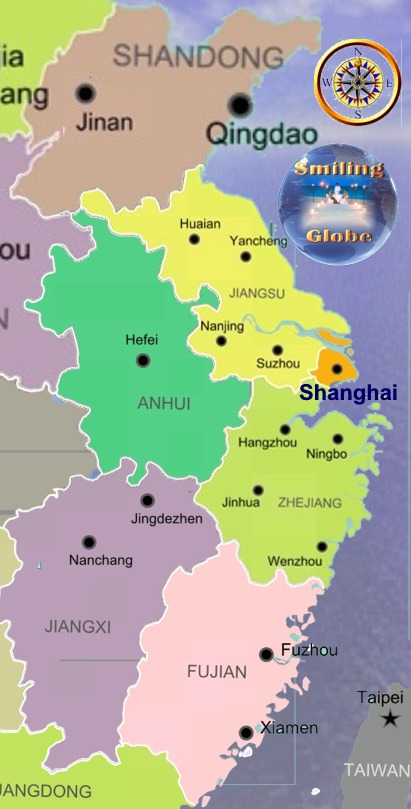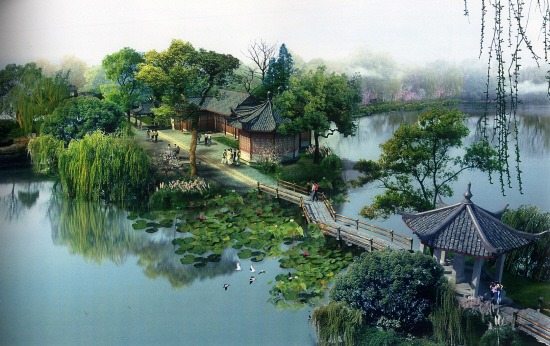Read more about
Wuxi Jiangsu.
East China
East China or Eastern China is a geographical and a loosely-defined cultural region that covers the eastern coastal area of
China.
Although an intangible and loosely defined concept, for administrative and governmental purposes the region is defined by the Chinese Central Government to include the provinces of (in alphabetical order)
Anhui,
Fujian,
Jiangsu,
Jiangxi,
Shandong, and
Zhejiang, as well as the municipality of Shanghai. Since the Chinese government claims Taiwan and the few outlying islands of
Fujian governed by the Republic of China (Taiwanese government) as its territory, China´s pseudo-province "Taiwan Province,
People´s Republic of China" is also classified in this region.
| Region |
Area |
Population |
Density |
|
| Jiangsu |
102,600 km2 |
79,200,968 |
770/km2 |

|
Cities: Nanjing (Jiangsu Province), capital under several dynasties, most recently 1912-1949
Suzhou (Jiangsu Province), old city of canals and gardens, now a major center for high tech. The Chinese have a saying that heaven has paradise but Earth has
Hangzhou and
Suzhou.
Nanjing
is one of the most beautiful cities of mainland China
with lush green parks, natural scenic lakes, small mountains, historical
buildings and monuments, relics and much more, which attracts thousands of
/Provence?s every year.
|
| Shandong |
157,100 km2 |
96,880,000 |
620/km² |
Cities: Jinan, is the capital city of Shandong since Ming dynasty, renowned for its 72 Famous Springs.
|
| Anhui |
139,600 km2 |
59,900,000 |
430/km² |
Cities: Hefei formerly known as
Ho-fei,
Luzhou, or
Luchow is the capital and largest city of Anhui Province in Eastern China. A prefecture-level city, it is the political, economic, and cultural centre of
Anhui. Located in the central portion of the province, it borders Huainan to the north, Chuzhou to the northeast, Chaohu to the southeast and Lu'an to the west.
|
| Shanghai |
6,340.5 km2 |
23,710,000 |
3,630.20/km² |
Cities: Shanghai
is the largest Chinese city by population and the largest city proper by population in the world.
Shanghai
is one of the four direct-controlled municipalities, with a total population of near 24 million as of 2013. It is a global financial center, and a transport hub with the world´s busiest container port. Located in the Yangtze River Delta in East China,
Shanghai sits at the mouth of the Yangtze River in the middle portion of the Chinese coast. The municipality borders the provinces of
Jiangsu and
Zhejiang to the north, south and west, and is bounded to the east by the East China Sea.
|
| Jiangxi |
166,900 km2 |
45,000,000 |
270/km² |
Cities: Nanchang is the capital of Jiangxi Province in southeastern China, located in the north-central portion of the province. As it is bounded on the west by the Jiuling Mountains, and on the east by Poyang Lake, it is famous for its scenery, rich history and cultural sites. Because of its central location relative to the Yangtze and Pearl River Delta regions, it is a major railroad hub in Southern China.
|
| Fujian |
121,400 km2 |
37,500,000 |
330/km² |
|
Cities: Fuzhou
is the capital of Fujian
province, formerly romanised as Fukien or
Foukien, is a province on the southeast coast of mainland China.
Fujian is bordered by
Zhejiang
to the north, Jiangxi to the west, and
Guangdong to the south. Taiwan lies to the east, across the Taiwan Strait
|
| Zhejiang |
102,000 km² |
54,426,891 |
533/km² |
Cities: Hangzhou
(Zhejiang Province), former capital with a famous lake, one of
China´s top destinations for domestic /Provence?s. Marco Polo wrote of Hangzhou the city is beyond dispute the finest and the noblest in the world.
Hangzhou is renowned for its historic relics and natural beauty. It is often known as one of the most beautiful cities in
China, also ranking as one of the most scenic cities. Although
Hangzhou has been through many recent urban developments, it still retains its historical and cultural heritage.
|
 |
| East China Hangzhou lake |
Originally, Hangzhou and
Nanjing were the great cities of this region; both have been the
capital of
China.
Suzhou was another important city, famous for its gardens, canals and silk. It was the capital of the Kingdom of Wu at a time when
China was divided.
In the 19th century, after one of the Opium Wars, China was forced to open certain
Treaty Ports to foreign trade. The two in this region were Ningbo, which until then had been mainly the port for Hangzhou, and
Shanghai, until then an insignificant town strategically positioned near the mouth of the Yangtze. Both developed rapidly after that. By the early 20th century,
Shanghai became one of the
world´s richest and wildest cities.
Then everything went wrong; this region was one of the areas of China that Japan succeeded in conquering, and they suffered horrendously under Japanese rule, 1937 to 1945. Then there were the Chinese Civil War, 1945-1949, the Great Leap Forward in the 50s, and the Cultural Revolution 1966-1976; all caused additional problems in this area.
In the "reform and opening up" since 1978, this area has benefited enormously.
Shanghai is again definitely one of the
world´s greatest cities;
Hangzhou,
Suzhou and
Nanjing are not far behind. All are very modern cities with lots of large new buildings, more under construction, and subway systems either in service or under construction. The entire region is a hive of industry, one of the most prosperous in
China. It is a magnet for migrants from poorer regions who come here in droves seeking work.
Ningbo, is a seaport city in the northeast of
Zhejiang province,
People´s Republic of China. Holding
sub-provincial administrative status
and separate state-planning status, as of the 2010 census, the
municipality has a population of 8,605,700 inhabitants, 3,491,000 of
whom reside in the urban area which comprises 6 districts.
 af East China , Do you have rice or praise for this Bed and Breakfast, Write your review
af East China , Do you have rice or praise for this Bed and Breakfast, Write your review  af East China , Do you have rice or praise for this Bed and Breakfast, Write your review
af East China , Do you have rice or praise for this Bed and Breakfast, Write your review ![]()